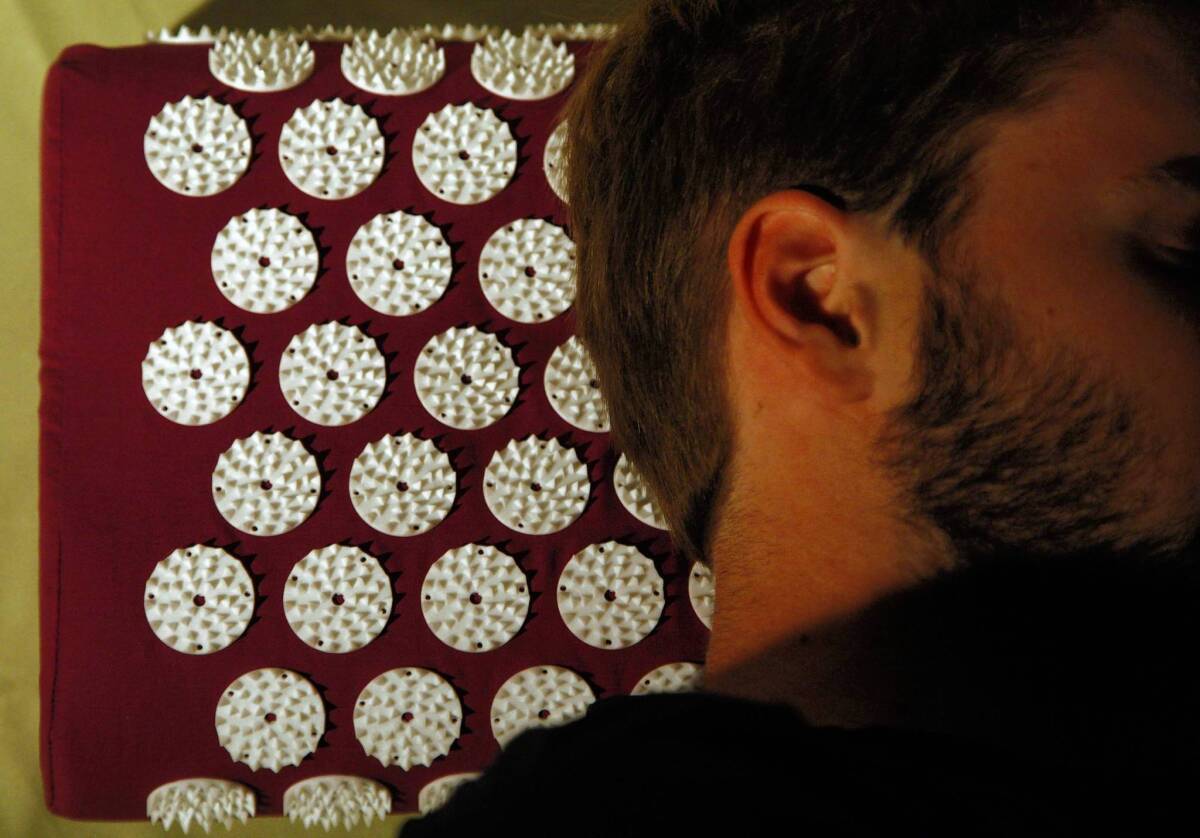Gadgets: Pillow designs stuffed with health and beauty claims

Pillows. They’re not just for nestling your noggin anymore. They’re also for keeping your stiff neck from aching, your sinuses from congesting, your acids from refluxing, your snores from snorting, your tinnitus from tintinnabulating and — yes! glory be! — your face from turning into a prune.
Or, so go some of the claims. Here’s a heads-up on how well the hype holds up.
Acupressure pillows. Laying your head on a bunch of pointy spikes may not sound especially therapeutic. But that’s the basic principle involved in acupressure pillows, which are intended to relieve headaches and stiff necks.
“You have to reach a certain pain threshold in order to get the benefits,” says StJohn Wiles, chief executive of Halsa in Warwick, N.Y., which markets the Halsa pillow. “But after you’ve used it once or twice, you don’t notice any discomfort anymore.”
Like acupressure therapy, the pillow spikes are supposed to stimulate the release of natural pain-relieving hormones. “Our users swear by their effectiveness,” Wiles says. And a Swedish study published in the Journal of Alternative and Complementary Medicine in 2011 found that lying on an acupressure mat, which uses the same pointy spikes, helped people relax (as measured by their physiological responses).
Acupressure pillows are meant to be used about 15 minutes a day. But if you zonk out on one, no harm done.
Sinus congestion-prevention pillows. Your pillow can be a great place for dust mites to hang out, feasting on the dead skin cells you serve up for them every night. You might never even know you have all those hungry guests unless you’re allergic to them, in which case they may well announce their presence by giving you sinus congestion. A dust mite-proof pillowcase is your best defense, says Dr. Mark Aronica, an asthma specialist at the Cleveland Clinic. Dust mites will set up housekeeping in an ordinary pillowcase, whether or not you have a hypoallergenic pillow. (They’ll also take up residence in your mattress and bedding, so you need to take additional steps to battle them there.)
For sinus congestion not caused by an allergic reaction, “all you can do is prop yourself up so your nose is higher than your heart,” says Alan Kominsky, a physician in Cleveland Clinic’s Head and Neck Institute. “Any pillow can do that.”
Anti-acid reflux pillows. Gravity is a natural antidote to acid reflux since it can help keep your stomach contents down where they belong. Pillows designed to reduce acid reflux rely on this fact, but Kominsky questions whether using such a pillow is the most effective measure. “You really have to tilt the whole bed,” he says. “One way is to put a brick under the headboard.” You definitely don’t want a pillow that makes you bend at the waist, he warns. By pushing stomach contents up instead of keeping them down, “that might even make your acid reflux worse.”
Speaker pillows. Speaker pillows are meant to block out, or mask, sounds that keep you awake — the snores from your bed partner (but see below!) or the rings, buzzes and whistles of tinnitus — with sounds that help you get to sleep, such as a dull monotone or the strains of Brahms’ Lullaby.
Masking tinnitus doesn’t work for everyone. To see if it’s likely to work for you, try the “faucet test”: Stand by a faucet that’s turned on as high as it will go. If you can’t hear your tinnitus over the sound of the gushing water, masking is probably worth a try.
No-more-snores pillows.
For many of these, the goal is to keep your airway as open as possible by keeping your chin lifted away from your chest. There’s an assortment of pillows that use an assortment of designs that are intended to accomplish that, but there’s not much research to support the use of any particular one of them, says Dr. Joseph Kaplan, director of the Mayo Sleep Center at the Mayo Clinic in Jacksonville, Fla.
Fountain of Youth pillows. To review, sleeping on your back can make you snore, and it can be bad for sleep apnea patients too. But uh-oh. The American Academy of Dermatology says sleeping on your side, with your face rubbing against your pillow night after night, can give you wrinkles.
It’s a dilemma all right. One possible solution: the Cupron pillowcase. An unpublished but randomized controlled trial of 55 women and two men found that after four weeks the appearance of both facial wrinkles and crow’s-feet was significantly reduced for those who slept on this pillowcase compared with those who slept on regular pillowcases. The Cupron case’s unique feature is the copper oxide it contains, which some believe stimulates the production of collagen.
Long before there were copper oxide pillowcases, there were silk and satin ones, which are thought to lessen wrinkle production by minimizing friction between face and pillow. More recently, the Save My Face pillow was invented to minimize any contact between face and pillow at all. Shaped like back-to-back letter Cs, it lets you position your cheek in the opening, thus touching nothing but air, while your head is supported because your temple and jaw rest on the pillow.
“Some of my patients like it,” says Dr. George Sanders, a plastic surgeon in Encino. “They don’t see wrinkle lines when they get up anymore. Others say it doesn’t work for them.”
In fact, how much benefit any pillow can give may depend to some extent on just whose noggin is nestling on it. “If you think a pillow will help,” Aronica says, “then potentially it will.”






